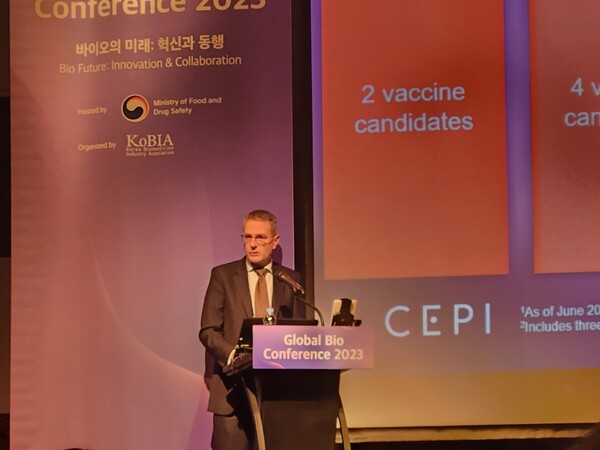The Coalition for Epidemic Preparedness Innovations (CEPI) highlighted the importance of working on the preparedness stage, emphasizing the need to establish alternative clinical evidence to facilitate rapid vaccine development in alignment with the CEPI's 100-day mission.
CEPI's 100-day mission refers to developing and delivering a safe, effective, and affordable vaccine against any new pathogen with pandemic potential within 100 days of its identification.

The 9th Global Bio Conference (GBC), which started on Wednesday in Seoul, will run until Friday featuring recent global trends and future forecasts in the biopharmaceutical field in the areas of vaccines to cell and gene therapy products.
“When you analyze the Covid-19 timeline which took around 326 days, you can only shave off a few days to something like 256 days,” said Adam Hacker, CEPI’s Head of Global Regulatory Affairs, at GBC 2023. “You can't go any faster by just squeezing timelines, we have to start doing things differently from the traditional approach.”
In this regard, he mentioned work that is being done in the regulatory space at forums like COVAX Regulatory Advisory Group (RAG) and other discussions to reduce the regulatory timeline.
Lessons from the Covid-19 pandemic need to be comprehensively merged into a consolidated format to produce a long-lasting guide to streamline workflows, he suggested.
He also mentioned the potential for cloud-based regulation to act as a collaborative forum for regulators.
Hacker highlighted maximizing platform data such as CMC manufacturing, non-clinical, immune response, and dose safety, creating frameworks for immune correlates of protection, and starting to assess the anticipated benefit-risk to facilitate the preparation phase of CEPI’s 100-day mission.
He mentioned the Covid-19 pandemic as a use case for how previous platform data enabled Covid-19 vaccines to quickly adapt to the changing strains. He also mentioned that Chikungunya vaccines often experience difficulty in setting up clinical data to prove vaccine efficacy and are thus trying to use correlates of protection to prove vaccine efficacy.
“There has been lots of research done to understand the immune response of Covid-19 than any other vaccine but it’s still difficult to fully identify the immune mechanism of action," explained Hacker. “It is important to look at other data such as correlates of protection to quickly establish vaccine efficacy in the absence of other clinical data.”
Furthermore, he pinpointed how the Filoviruses can be used to provide immuno-bridging data across different diseases.
Immune-bridging infers effectiveness based on comparing immunological results with a new vaccine, formulation, or subgroup with immunological results in a situation with known efficacy.
As there is not much clinically available data on Filoviruses, this approach is being considered and can also be applied to pandemics to facilitate rapid vaccine deployment, stated Hacker.
In particular, he pointed out work being done with Benefit-Risk Assessment of Vaccines by Technology (BRAVATO) to develop harmonized guidelines for the assessment of potential safety concerns of multiple vaccines to help inform decision-making and facilitate communication concerning licensure and development.
To condense the vaccine development timeline against disease X, Hacker suggested the following approach.
“In the early stages of an outbreak, the case fatality rate (CFR) is always higher so we need to do some modeling to determine the real CFR and then feed this information into the benefit-risk analysis,” explained Hacker. “Rapid vaccine development also requires working in parallel by assessing phase 1, 2, and 3 data and filing this data in on an ongoing basis together with an assessment of benefit-risk.”
He went on to explain that once the pivot towards the benefit-risk analysis is concluded, it will pave the way for a managed distribution of the vaccine to high-risk individuals. As real-world evidence accumulates over time, this accumulation of data will subsequently support the comprehensive worldwide distribution through collaborative efforts.
Related articles
- [Reporter’s Notebook] Korea pulling out all the stops, will it be enough for the next pandemic?
- [GVIRF 2023] WHO, CEPI, AVMI say establishing regional manufacturing easy but sustaining it difficult
- [GVIRF 2023] KDCA unveils preview into Korea’s future pandemic response strategy
- [GVIRF 2023] 'Vaccines should be deployed in 6 months in a new pandemic'
- IVI Director General highlights balancing vaccine sovereignty with joint global response

